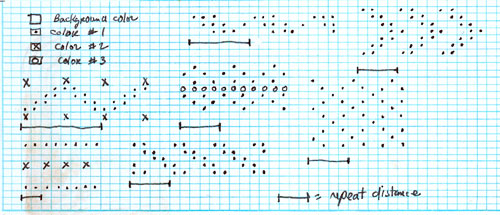
This lesson will concentrate on patterns that are added to a garment to vary color and texture rather than those such as ribbing that serve a utilitarian purpose.

Make a swatch 3 to 4 inches wide. If you like the pattern, continue knitting until the piece's length will reach around the head of an adult person or child. Next cast off and sew the cast on edge to the cast off edge. With a 16" circular needle, pick up and knit the edge stitches and knit around in stockinette or another pattern until the piece is 5 to 6 inches deep for an adult.
Divide the number of stitches by 7 or 8 and decrease evenly around the marked stitches every second round until only 7 or 8 stitches remain changing to sock needles when necessary. Break off the yarn and thread it through the stitches and bind in to finish the hat. If you want a flat rather than a pointed top, start to decrease every round when 40 to 50 stitches remain.
Vertical patterns - start 4-5 stitches from a non-curl edge.
Ribbing
Cables, 2x2 crossed every six rows
row 1: P2, K4, P2 (right side)
row 2: K2, P4, K2
row 3: P2 , K4, P 2
row 4: K2, P4, K2
row 5: P2, Cross 2 stitches (see below), P2
row 6: K2, P4, K2
Cross of 2x2 cable: Place 2 stitches on a cable or double point needle and hold to the front of your work. Knit the next two stitches from the left needle. Put the stitches from the cable needle onto the left needle and knit them.
Cable variations: cross over a different number of rows, the shorter the distance between crosses, the tighter the twist on the cable. Change the width of the cable: 1x1, 2x2, 3x3, and 4x4 are all different in appearance. Change the direction of crossing--hold cable in back of work.
Knit and Purl Patterns

On a 16 " circular needle, cast on enough stitches to reach comfortably around the head. Make a border by (1) knitting back and forth for a garter stitch edge or (2) ribbing. When the border is about 1 1/2 inches long (minimum, go for at least 4 inches if you want to turn up the edge) knit several rounds putting in a few increases if desired. Begin the color pattern using some of the designs given below or draft your own on graph paper using two rules:
Carry one color on each hand, be sure to let the loop in the back stay slack so the work doesn't pucker up. When the work is about 4 to 5 inches above the cuff, decrease to close the top as in the aran hat.
Besides the general knitting books already recommended, many of the knitting dictionaries have directions (example: Mon Tricot). The British Isles take the prize for textured Fisherman designs while Scandanavia and Fair Isle are noted for color patterns. Look up patterns from your own heritage! Fine traditions in knitting originated all over Europe, Africa, South America, and Asia.
Gladys Thompson, "Patterns for Guernseys, Jerseys & Arans, Fisherman's Sweaters from the British Isles," 2nd ed., Dover publications,Inc., New York, 1971.
(Patterns for fisherman knit sweaters and one hat complete with accounts of the villages and adventures she encountered getting them)
Barbara G. Walker, "The Craft of Cable-Stitch Knitting," Scribners, New York, 1971.
(All patterns with general directions for designing your own sweaters in the front)
